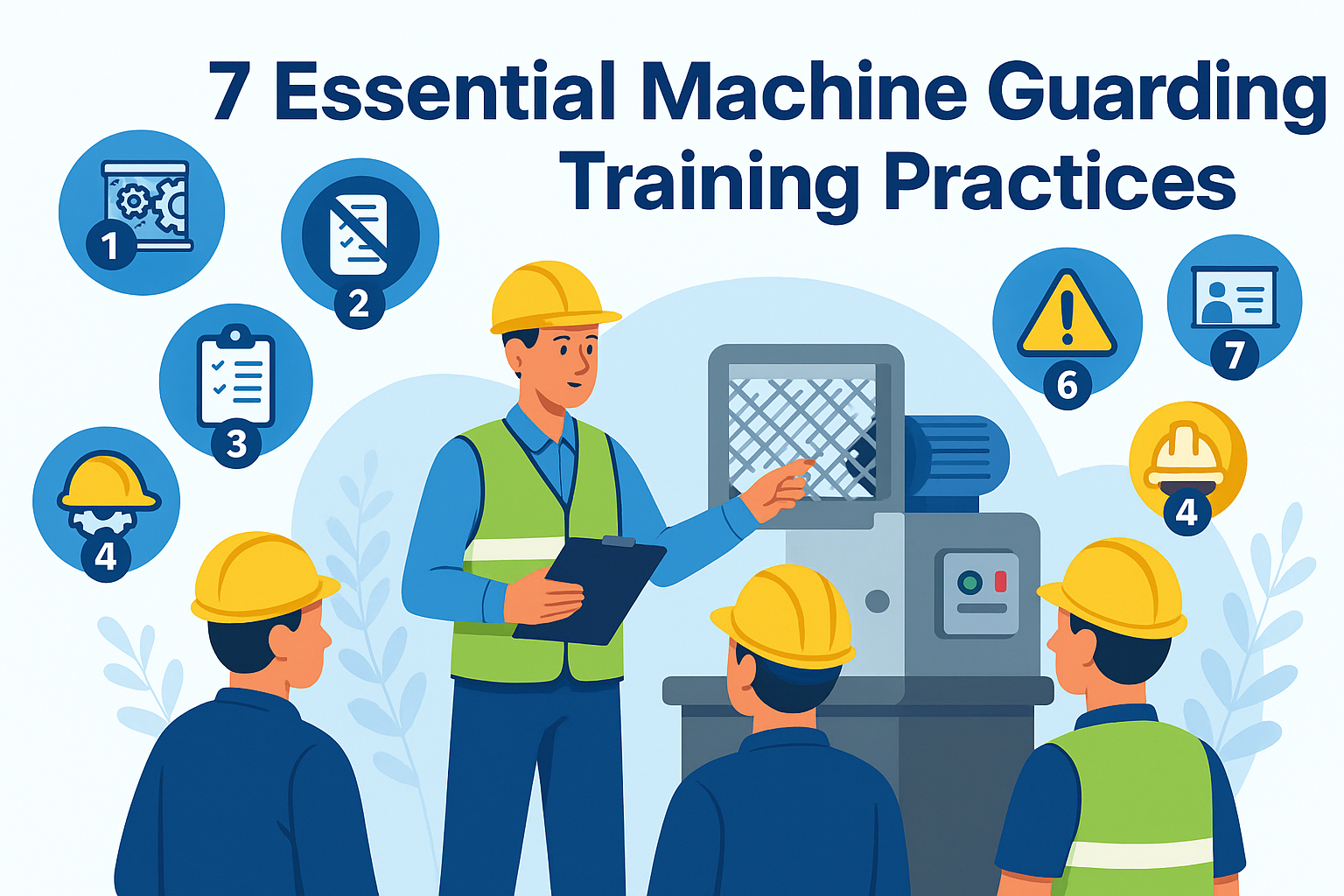
7 Essential Machine Guarding Training Practices for Operators
Machine guarding is one of the most critical aspects of industrial safety. Moving parts, pinch points, flying chips, and sparks can injure operators within seconds if not properly protected. Effective machine guarding training ensures operators know how to use guards correctly, recognize hazards, and comply with regulations.
This article outlines 7 Essential Machine Guarding Training Practices every operator should follow to stay safe and compliant.
Why Machine Guarding Training Matters
- Accident Prevention: Guards protect against cuts, crushing, amputations, and eye injuries.
- Regulatory Compliance: OSHA 29 CFR 1910 Subpart O mandates machine guarding.
- Productivity: Well-maintained guards reduce downtime from accidents.
- Safety Culture: Training shows management’s commitment to worker well-being.
External link tip: OSHA Machine Guarding provides official guidelines.
Practice 1: Understand Types of Machine Guards
Operators should know the different types of guards and their functions:
- Fixed Guards: Permanent barriers around dangerous parts.
- Interlocked Guards: Shut down the machine if opened or removed.
- Adjustable Guards: Adapt to different tasks or materials.
- Self-Adjusting Guards: Automatically move into position as material is fed.
Example: A drill press uses an adjustable guard to shield the rotating bit.
Training Tip: Use actual equipment to show how each guard type works.
Practice 2: Never Remove or Bypass Guards
Removing or disabling guards is a leading cause of injuries. Operators must learn:
- Only authorized maintenance personnel may remove guards — never operators during production.
- Always shut down and lockout/tagout machines before guard removal.
- Report missing or damaged guards immediately.
Example: An operator who notices a loose guard stops work and notifies a supervisor instead of continuing.
Training Tip: Reinforce this with real-life case studies of accidents caused by bypassed guards.
Practice 3: Conduct Pre-Operation Safety Checks
Before starting any machine, operators should:
- Inspect guards for proper installation and damage.
- Ensure safety interlocks are functioning.
- Confirm guards don’t interfere with normal operation or visibility.
- Check emergency stop buttons are accessible.
Example: A press brake operator does a quick guard check as part of a daily checklist.
Training Tip: Provide a simple pre-operation inspection checklist to all operators.
Practice 4: Use Personal Protective Equipment (PPE) Alongside Guards
Machine guards reduce risks but don’t eliminate them entirely. Operators should:
- Wear safety glasses, face shields, gloves, or hearing protection as required.
- Secure loose clothing, jewelry, and hair that could get caught.
- Understand when extra PPE is needed for maintenance or cleaning.
Example: A lathe operator wears eye protection even with a guard in place to stop chips from hitting their face.
Training Tip: Demonstrate the synergy between guards and PPE in training sessions.
Practice 5: Follow Safe Work Procedures and Lockout/Tagout
Machine guarding training must integrate with other safety practices:
- Use standard operating procedures (SOPs) when starting, operating, and stopping machines.
- Lockout/tagout before cleaning, adjusting, or repairing equipment.
- Only restart equipment after confirming guards are properly reinstalled.
Example: A maintenance worker installs a new guard after repair and only then removes their lock.
Training Tip: Include lockout/tagout basics in machine guarding training for operators.
Practice 6: Report and Respond to Guarding Problems Immediately
Operators are the first to notice issues. Training should cover:
- How to report damaged or missing guards.
- Stopping work until hazards are corrected.
- Using signage like “Out of Service” or “Do Not Operate.”
- Following supervisor instructions during interim fixes.
Example: A conveyor guard breaks during shift; the operator tags the machine and notifies maintenance before anyone gets hurt.
Training Tip: Encourage a “stop work authority” culture where operators won’t be penalized for halting unsafe operations.
Practice 7: Participate in Regular Refresher Training and Drills
Machine guarding practices evolve with new equipment and standards:
- Attend refresher training annually or when new machines arrive.
- Participate in safety drills and toolbox talks on machine hazards.
- Share lessons learned from incidents or near-misses.
Example: Operators attend a quarterly safety meeting focused on new guarding technology.
Training Tip: Use quizzes, interactive demos, or VR simulations to make refreshers engaging.
Implementing Machine Guarding Training for Operators
To make these practices effective:
- Hands-On Learning: Show guards on real machines.
- Visual Aids: Use diagrams, videos, and photos of correct guarding.
- Assess Competency: Quizzes or on-the-job assessments confirm understanding.
- Document Training: Keep records for audits and compliance.
Benefits of 7 Essential Machine Guarding Training Practices
- Reduced Injuries: Protects workers from amputations, cuts, and eye injuries.
- Compliance: Meets OSHA/NEBOSH/ISO standards for machine guarding.
- Improved Morale: Workers feel safer and more confident.
- Increased Productivity: Fewer accidents mean less downtime.
Key Takeaways
Machine guards save lives — but only when used correctly. By teaching these 7 Essential Machine Guarding Training Practices, you empower operators to protect themselves and others while keeping production running smoothly.
Suggested Internal & External Links
- External: OSHA Machine Guarding
- Internal: 5-Step Lockout Tagout Safety Training Guide for Maintenance Teams
- 10 Powerful Electrical Safety Training Tips to Prevent Shocks
- 12 Ultimate Fire Prevention Training Tips for Workers
- 6 Proven Emergency Preparedness Training Drills for Any Industry
- 8 Critical Fire Safety Training Lessons to Save Lives
Frequently Asked Questions
1. Why is machine guarding training important for operators?
It teaches them how to use guards properly, recognize hazards, and comply with safety regulations, reducing accidents and injuries.
2. How often should machine guarding training be refreshed?
At least annually or whenever new machines, guards, or processes are introduced.
3. Can operators remove machine guards for maintenance?
No. Only authorized maintenance staff may remove guards, and only after lockout/tagout procedures are in place.
4. What types of machine guards should operators know?
Fixed, interlocked, adjustable, and self-adjusting guards, each designed for specific applications.
5. How can you make machine guarding training engaging?
Include hands-on demonstrations, videos, case studies, and interactive quizzes to reinforce learning.